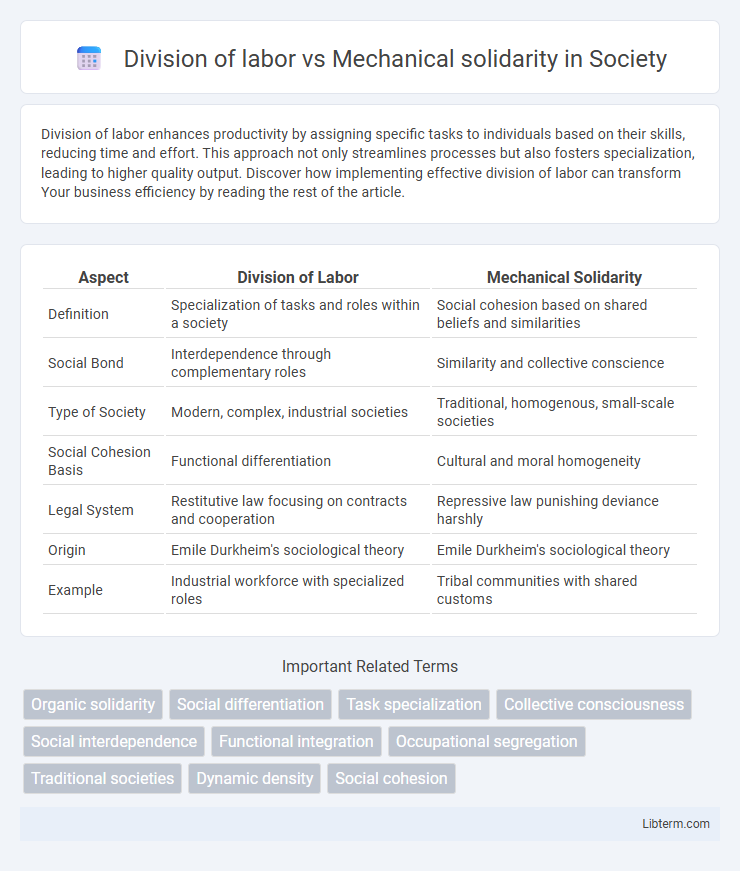Division of labor enhances productivity by assigning specific tasks to individuals based on their skills, reducing time and effort. This approach not only streamlines processes but also fosters specialization, leading to higher quality output. Discover how implementing effective division of labor can transform Your business efficiency by reading the rest of the article.
Table of Comparison
| Aspect | Division of Labor | Mechanical Solidarity |
|---|---|---|
| Definition | Specialization of tasks and roles within a society | Social cohesion based on shared beliefs and similarities |
| Social Bond | Interdependence through complementary roles | Similarity and collective conscience |
| Type of Society | Modern, complex, industrial societies | Traditional, homogenous, small-scale societies |
| Social Cohesion Basis | Functional differentiation | Cultural and moral homogeneity |
| Legal System | Restitutive law focusing on contracts and cooperation | Repressive law punishing deviance harshly |
| Origin | Emile Durkheim's sociological theory | Emile Durkheim's sociological theory |
| Example | Industrial workforce with specialized roles | Tribal communities with shared customs |
Introduction to Division of Labor and Mechanical Solidarity
Division of labor refers to the specialization of tasks within a society, increasing efficiency by dividing production processes into distinct roles. Mechanical solidarity is a form of social cohesion found in traditional societies where individuals share similar values, beliefs, and lifestyles, resulting in collective conscience. Emile Durkheim introduced these concepts to explain how social order is maintained in different types of societies based on the nature of labor and social bonds.
Defining Division of Labor
Division of labor refers to the systematic organization of work where tasks are divided among individuals or groups to increase efficiency and productivity, often leading to specialization in skills. This concept contrasts with mechanical solidarity, a social cohesion based on the homogeneity of individuals performing similar work and sharing common values. Emile Durkheim emphasized that division of labor fosters organic solidarity through interdependence, whereas mechanical solidarity arises in simpler societies with less differentiation in labor roles.
Understanding Mechanical Solidarity
Mechanical solidarity refers to the social cohesion found in traditional societies where individuals perform similar tasks, share common values, and maintain collective consciousness. It contrasts with the division of labor, which characterizes more complex societies by specialized roles and interdependence among individuals. Understanding mechanical solidarity involves recognizing how uniformity and shared beliefs strengthen group unity despite limited individual differentiation.
Key Differences between Division of Labor and Mechanical Solidarity
Division of labor refers to the specialization of tasks within a society, enhancing efficiency through differentiated roles, while mechanical solidarity is a social cohesion based on similarities and shared beliefs in traditional societies. Division of labor promotes interdependence among individuals due to task differentiation, whereas mechanical solidarity relies on collective conscience and homogeneity for social integration. Key differences lie in their foundations: division of labor arises from economic specialization, whereas mechanical solidarity stems from cultural and moral uniformity.
Social Structures Shaped by Division of Labor
Social structures shaped by the division of labor exhibit increased specialization, where individuals perform specific tasks contributing to overall societal function. Mechanical solidarity relies on homogeneity and shared beliefs, typical in traditional societies, while organic solidarity emerges in complex societies with interdependence due to differentiated roles. This shift from mechanical to organic solidarity highlights how division of labor transforms social cohesion by fostering functional interconnections among diverse social groups.
Community Bonds under Mechanical Solidarity
Mechanical solidarity strengthens community bonds through shared beliefs and collective consciousness, fostering social cohesion in traditional societies. Uniformity in values and norms creates strong interpersonal connections and mutual support, reinforcing social integration. This contrasts with the division of labor in modern societies, where specialization leads to organic solidarity based on interdependence rather than likeness.
Evolution of Societies: From Mechanical to Organic Solidarity
The evolution of societies reveals a transition from mechanical solidarity, characterized by shared beliefs and homogeneity among members, to organic solidarity, where division of labor fosters interdependence and social cohesion through specialized roles. In traditional societies, mechanical solidarity unifies individuals with similar tasks and values, while modern complex societies rely on organic solidarity to integrate diverse functions and expertise. This shift highlights the sociological significance of labor specialization in facilitating social stability and cooperation within contemporary communities.
Division of Labor: Impacts on Social Cohesion
Division of labor increases social cohesion by fostering interdependence among individuals through specialized roles, which strengthens societal bonds and promotes collaboration. It enables efficient functioning and productivity within complex societies by creating complementary tasks that require cooperation. However, excessive specialization can risk alienation or fragmentation if individuals lose a sense of collective identity.
Mechanical Solidarity in Traditional Societies
Mechanical solidarity in traditional societies is characterized by homogeneity in work, beliefs, and values, where individuals perform similar tasks and share a collective conscience. Social cohesion arises from shared experiences and strong interpersonal bonds within small, close-knit communities. This type of solidarity contrasts with the division of labor in modern societies, where specialized tasks create interdependence among diverse individuals.
Contemporary Relevance and Sociological Perspectives
Contemporary sociological perspectives emphasize that the division of labor fosters interdependence in complex societies, aligning with Durkheim's concept of mechanical solidarity where social cohesion arises from shared beliefs and homogeneity. In modern contexts, mechanical solidarity persists in tightly-knit communities and groups with common values, serving as a counterbalance to the labor specialization that characterizes industrialized economies. Understanding this dynamic informs analyses of social integration, collective conscience, and the challenges posed by increasing social differentiation and cultural diversity.
Division of labor Infographic

 libterm.com
libterm.com